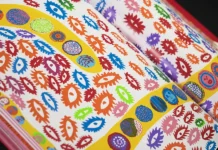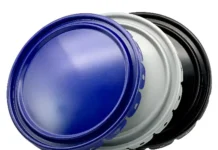In the 3rd and 4th Quarter 2023 issues of UV+EB Technology, we discussed the preparation of nanocomposites made by incorporating carbon nanotubes (CNTs) into UV-polymerizable formulations. 1, 2 Those two articles summarized the experimental techniques developed by undergraduate students at the University of Houston-Downtown to determine how well single-walled carbon nanotubes (SWNTs) were dispersed (exfoliated) into an acrylate-functional medium and the effects observed of the SWNTs on the reactivity and other properties of UV-polymerizable systems. In that study, SWNTs were added to formulations at concentrations ranging from 0.00 to 0.20 pph based on the total mass of the monomers and the oligomer. That research was reported at RadTech 2006 in Chicago, Illinois. 3 Subsequently, other students continued the studies of SWNT-containing UV-polymerizable formulations at concentrations from 0.35 to 1.00 pph of the monomer/oligomer mixture. Further, they also investigated systems containing multi-walled carbon nanotubes (MWNTs) at 0.20 pph. This work was presented at RadTech 2008 in Chicago 4 and is the subject of this edition of “Professor’s Corner.”
Studies of UV-Polymerizable Formulations Containing Higher Concentrations of SWNTs
Modification of Dispersion Techniques
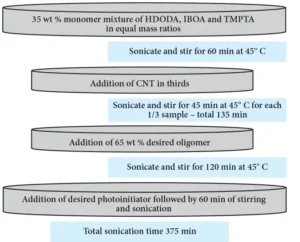
In the initial study of CNT nanocomposites, a relatively simple procedure was developed for dispersing the SWNTs in concentrations up to 0.20 pph. However, when higher concentrations of SWNTs were used, mixtures occurred that appeared to have significant agglomeration of the nanotubes, resulting in very non-uniform dispersions of the SWNTs. Thus, more work was required to achieve adequate exfoliation of the SWNTs. With the newer dispersion techniques, stable nanocomposites containing 0.35, 0.50, 0.75 and 1.00 pph SWNTs successfully were prepared.
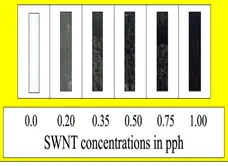
As in the previous study, an acrylate-functional aliphatic urethane oligomer was used at 65%-by mass. Figure 1 shows a schematic representation of the dispersion technique used for these formulations. It involved significantly higher total sonication time than in the previous study. As expected, the opacity of thin films of the nanocomposites increased with increasing concentration, as is depicted in Figure 2.
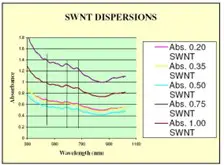
During the previous investigation, Van Hove singularities (see Reference 5 for a description) failed to appear in the formulations containing more than 0.20 pph SWNTs, a strong indication that exfoliation had not occurred. However, in this latter study and with increases in sonication time, they clearly were evident for all five samples. These data are shown graphically in Figure 3. Clearly, the increased sonication time proved to be very effective at exfoliating the SWNTs. Note that the resulting absorbance curves shown in Figure 3 were not in order of increasing concentration. This was, most likely, due to slight differences in the film thicknesses that, according to Beer’s law, would have an effect on the absorbance.
Rheology of SWNT-Containing UV-Polymerizable Formulations
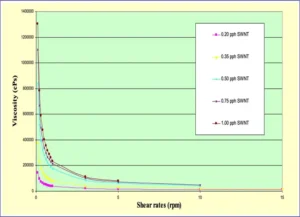
Figure 4 shows the viscosity vs. shear rate data for the formulations containing higher levels of SWNTs. The viscosities of the formulations increased uniformly with SWNT concentration. But, with increasing shear rate, every formulation demonstrated significant shear thinning down to a limiting viscosity. These data are consistent with the data from the UV/visible spectroscopy data, indicating good dispersion of the nanotubes. However, the shear thinning properties indicate that the interaction among the SWNTs and the acrylate-functional materials – dipole-induced dipole attractions – were relatively weak; easily broken down under low-shear conditions.
Note: The oligomers used in the study were proprietary, but References 6 and 7 provide a general description.
Studies of UV-Polymerizable Formulations Containing MWNTs
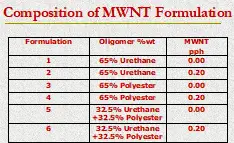
MWNTs are carbon nanotubes containing several concentric rolled graphene cylinders. Compositionally, they are expected to be much more heterogeneous than SWNTs, both in the number of cylinders per MWNT nanotube and in cylinder length. Because of this, it was expected that they might be more difficult to exfoliate than were the SWNTs. But, it was found that using the updated dispersion technique involving enhanced sonication and stirring previously developed for SWNT nanocomposites did produce MWNT-containing nanocomposites that were uniform in appearance and stable with respect to phase separation. However, when UV-polymerized films of the formulations were prepared and subjected to UV/visible spectroscopy, they did not show the presence of Van Hove singularities. In spite of this, rheological studies – as well as shelf-life stability – indicated good exfoliation. The heterogeneous nature of the MWNTs, more than likely, explains the absence of clear Van Hove singularities in the spectra.
The formulations investigated in this part of the study contained three different oligomer packages, all at 65% by mass. The first formulation contained the same acrylate-functional oligomer as the SWNT study. The second one contained an acrylate-functional polyester oligomer, and the third one contained a 50/50-by-mass mixture of the two. Table 1 shows the oligomer and MWNT compositions evaluated in this study. Each formulation contained an equal mass mixture of the same three acrylate-functional monomers used in the SWNT study: isobornyl acrylate (IBOA), 1,6-hexanediol diacrylate (HDODA) and trimethylolpropane triacrylate (TMPTA). This monomer mixture represented 35.0%-by-mass of the formulation.
In the next edition of “Professor’s Corner”, we will review the rheological, thermal and thermomechanical properties of MWNT-containing UV-polymerizable formulations.
References
- “Professor’s Corner,” UV+EB Technology, Vol. 9, No. 3, pp. 16 & 17.
- “Professor’s Corner,” UV+EB Technology, Vol. 9, No. 4, pp. 14–16.
- V. Lam, G. Patino, C. Carandang, & B. Christmas, “UV-Polymerizable Systems Containing Single-Walled Carbon Nanotubes,” http://www.radtech.org/proceedings/2006/papers/093.pdf – Accessed September 28, 2023.
- N. Lam, D. Kurukji, S. Luce, & B. Christmas, “Acrylate-Functional Urethane- and Polyester-based Formulations Containing Multi-Walled Carbon Nanotubes,” https://www.radtech.org/proceedings/2008-toc.htm – Accessed February 24, 2024.
- G. Lanzani & L. Lüer, “Carbon Nanotubes: Electronic Structure and Spectroscopy”, Comprehensive Nanoscience and Technology, Vol. 1, 2011, pp. 23-39.
- V.Lam, G. Patino, C. Carandang, & B. Christmas, “UV-Polymerizable Systems Containing Single-Walled Carbon Nanotubes,” http://www.radtech.org/proceedings/2006/papers/093.pdf – Accessed June 16, 2023.
- N. Lam, D. Kurukji, S. Luce, & B. Christmas, “Acrylate-Functional Urethane- and Polyester-Based Formulations Containing Multi-Walled Carbon Nanotubes,” http://www.radtech.org/proceedings/2008/papers/113.pdf – Accessed June 16, 2023.
 Byron K. Christmas, Ph.D.
Byron K. Christmas, Ph.D.
Professor of Chemistry, Emeritus
University of Houston-Downtown
b4christmas@gmail.com




